|
Plant protection
Diseases
Root diseases
Black root disease (Rosellinia
arcuata)
Control measures
- Remove surface mulches around 10 m
- Drench soil with Dithane M 45 or Captan - 30 g / 10 litres of water
- Avoid soil rehabilitation
- Biocontrol agents Trichoderma or Gliocladium(200g/pit) may be incorporated at the
time of planting.
Red root disease (Poria
hypolateritia)
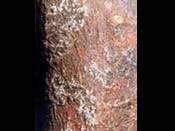
|
- Mycelium white, later turns red, in advanced stages may appear black
- Interwoven with adhering soil
- On washing soil goes off - blood red mycelium seen
|
- Fructification plate like with spores at collar -rarely seen
- Spreads mostly by root contact
- Alternate hosts : Coffee, grevillea, albizia, and erythrina
|
Brown root disease (Fomes
noxius)
- Slow spreading and quick killing
- Soil encrustation, which cannot easily be washed off
- Mycelium tawny brown resembling sambur skin
|

|
- Wood turns soft and spongy
- Honey- comb like reticulations on the wood
- Fructification seen on stumps- bracket shaped, irregular and hard
- Spores carried by wind, lodges on stumps of shade trees
- Infection spreads mainly through root contact
Alternate host : Coffee, Grevillea, Albizia, and Erythrina
|
Control measures:
Phytosanitary measures and drenching the soil with tridemorph or hexaconazole 0.5%
are recommended.
Charcoal stump rot (Ustulina
zonata)
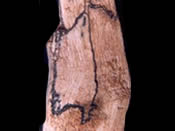
|
Pre-disposing factor
Symptoms
- White fan shaped mycelium on the surface of wood beneath the bark
- Charcoal like encrustation on bark, in advanced stages
|
Control measures
- Uprooting of affected bushes
- Forking and loosening soil
- Taking 60 x 60 x 60 cm pits 3-4 months ahead of planting
- Keeping them open for aeration
- Spraying dug out soil and pits with 1% copper oxychloride suspension
- Avoiding application of N in the first year of planting
Violet root rot (Sphaerostilbe
repens)
Pre disposing factor
|
Symptoms
- Leaves turn yellow and droop
- Presence of enlarged lenticels on root bark
- Roots become inky black/violet
- Develop rancid odour- vinegar smell
- Mycelium white, later turns to purple, seen on wood
|
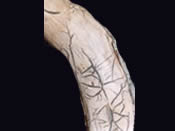
|
Control
- Avoid planting in water logged areas
Stem diseases
Collar canker (Phomopsis
theae)
- Pathogen invades the stem mostly through open wound
Predisposing factors
-
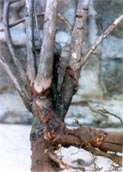 Planting in gravelly soils Planting in gravelly soils
- Mulching closer to collar
- Wound caused by weeding implements
- Fertilizer application close to the collar
- Low moisture status in bark
- Surface watering during dry weather
Symptoms
Highly susceptible clones
Control measures
- Avoid planting susceptible clones in gravelly soils and drought prone areas.
- Improve organic matter of marginal soils
- Use plants with good root system
- Remove affected portion by pruning the healthy wood and apply copper fungicide to
the cut ends.
Wood rot (Hypoxylon
serpens)
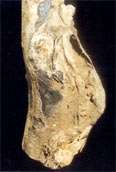
|
- Black encrustation (fructification) on stem
- Affected portion crumbles on gentle pressure
Control measures
Preventive
- Avoid pruning during dry weather
Curative
|
Leaf disease
Blister
blight (Exobasidium vexans)
Favourable conditions for infection :
- Cloudy weather (monsoon months)
- Leaf wetness for 11-13 hrs.
Pathogen entry and symptoms:
- Direct penetration through upper surface of leaf
- Infects only tender leaves and stem (pluckable shoots)
- Appearance of translucent spot
- Well developed lesion seen in 2 weeks
- Lesions sunken on the upper surface and convex at lower surface
|
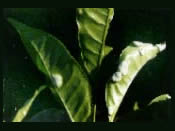
|
- Lower surface is first dull then grey and finally pure white
- Affected leaves are distorted- irregularly rolled
- Stem infection leads to goose neck shape, dieback and snapping at the point of infection
- Sporulation occurs after 10-19 days
- Spore discharge period- up to 8 days
- Number of spores ejected in 24 hours - 1.3 million / sq.cm
Control measures
Chemicals recommended (Pruned fields):
- Copper oxychloride -Protectant (inhibits germination of spores)
- Tridemorph (Calixin), hexaconazole (Contaf 5EC) and propiconazole (Tilt 25EC)
- Copper oxy Chloride 350g + Plantomycin 70g/ha at 3-4 days interval.
General strategy for management of pests
Cultural operations such as plucking, pruning, shade regulation and weed control
are manipulated to reduce the incidence of pests. Tea mosquito lays large number
of eggs on the broken ends of plucked shoots. Intensive removal of stalks during
plucking is recommended to reduce the incidence of this pest. Weeds offer excellent
hiding places and serve as alternate hosts for Helopeltis and red spider
mites. Growth of weeds and wild host plants in and around tea fields may be controlled
and this will help to reduce the incidence of pest. Severity of attack by shot hole
borer increases with the age of the field from pruning. Therefore, it is advised
to maintain the length of pruning cycles to 4 years in mid elevation areas. Application
of higher rate of K2O to the soil in the first year of the pruning cycle
significantly reduces the infestation by shot hole borer.
Biocontrol agents:
Minor status of many of the tea pests is mainly due to the influence of the biocontrol
agents. So far, more than one hundred species of predatory and parasitic insects
and mites have been reported from the tea estates of southern India. Data are also
available on the bioecology of the major parasitoids and predators. An exhaustive
list of natural enemies of tea pests is available in Journal of Plantation Crops,
2001, 29 (2): 1-10.
Use of botanicals:
Formulations containing azadirachtin have been found effective against pink and
purple mites and caterpillar pests such as flushworms and leaf rollers. Use of these
neem formulations are recommended mainly to save natural enemies and to reduce the
load of synthetic pesticides on tea.
Use of inorganic compounds,hydrocarbon oils:
Formulations of sulphur is effective against red spider mites. Recently, spray oil
from paraffinic base has been found effective against red spider mites. Since this
oil does not leave any residues in tea, it is incorporated into the mite control
programme in tea.
Integrated pest management (IPM):
During the last one decade, progress achieved to incorporate non-chemical control
strategies and to evolve an integrated pest management programme for tea. The package
of IPM practices for tea has been presented at the National Workshop, organised
by the Directorate of Plant Protection, Govt. of India and the same has been published
in the Planters Chronicle April 2002 issue( 98 (4) : 107-125).
Source: http://www.upasitearesearch.org/
|